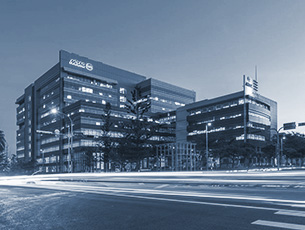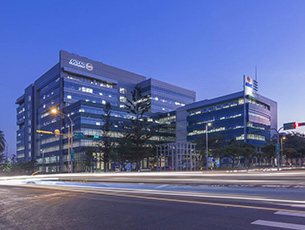Climate Change
MiTAC Group cares about global climate change, protecting the Earth’s resources and fulfilling our CSR. Besides continuing to promote greenhouse gas emission control in order to decrease coast, we also strive toward sustainable energy development that encompasses resource efficiency, energy conservation and environmental protection, so as to help materialize a low carbon economy and society.
|
Energy-Saving Target |
|---|
To exercise due diligence for social responsibility and implement progressive energy conservation and carbon reduction, we set the long-term and medium-term goals with reference to the SBTi. Annual reviews will be conducted and adjustments will be made in accordance with actual resource needs, the outcome of various improvement measures and adaptability/necessity.

|
Revision of energy conservation targets |
When any one of the following situations occurs in the future, we will re-calculate and revise the base year:
- Changes to operational boundaries.
- The ownership and control of GHG sources or sinks transferred into or out of organizational boundaries.
- Changes to GHG quantification methodologies that result in significant changes to quantified GHG emissions or removals. The significance threshold is 3%. The base year is set and revised according to the Company’s needs or related national policies.
|
Clean Energy Target |
|---|
|
|
We place great importance on the energy and GHG management to mitigate the impact of the climate change. MiTAC plants install solar photovoltaic panels (PV) in 2021 for the goal of 5% clear energy in 2022 and 10% clean energy in 2025. |
|
GHG Inventory |
|---|
Each year, the Company conducts the inventory of the GHG emissions in the previous year. The ISO 14064 third-party verification was completed for the first time in 2022, covering the data in 2020-2021. As for the inventory data of 2022, it was verified in the first half of 2023, with the inventory scope covering direct GHG emissions, indirect GHG emissions from imported energy, indirect GHG emissions from transportation (business trips, product transportation), indirect emissions from cleanup and disposal of waste, etc. The verification results are helpful for us to be better aware of the progress of the Group’s carbon reduction pathways.
Group GHG emissions and intensity

Note :
-
Sources of the carbon emission factor of the plants: Taiwan – 2021 emission factor announced by the Bureau of Energy; China – Notice on the Management of Greenhouse Gas Emissions Reporting by Enterprises in the Power Generation Industry from 2023 to 2025; California – PG&E Climate Strategy Report, June 2022.
-
GHG emissions were quantified using the GWP of IPCC AR6 (2021).
Carbon Emission and Intensity

- Besides setting legal compliance as the basic requirement, we make constant adjustments to lower environmental impact, including the design for environment (DFE) of products and enhancement of equipment efficiency. The intensity of GHG emissions is calculated based on the intensity of CO2 emissions (tCO2e/million NT$ output) for Scope 1 and Scope 2.
- Scope: include the Taiwan operating, R&D center and Factory; China major production locations: MSL in Guangdong/MKL.MISK in Jiangsu; assembly plant in California, USA: MiTACIS.
Power Consumption and Intensity

- Scope: include the Taiwan operating, R&D center and Factory; China major production locations: MSL in Guangdong/MKL.MISK in Jiangsu; assembly plant in California, USA: MiTACIS.
|
Actions and Effectiveness of Emissions Reduction |
|---|
Under the effects of global warming, the Company, as one of the citizens of the Earth, shall continue reducing the GHG emissions during the operating process to reduce the negative effect on the climate. Based on ISO 14064, we found that electricity consumption is the main source of GHG emissions for Category 1 and Category 2 (constituting more than 92%). With energy saving as a means for the reduction of carbon, we implement the GHG emission reduction plan in line with the greenhouse gas management guidelines of the local government and the reduction target of the Company.
|
Power / Energy Saving Measures and Programs
There were a total of seven energy saving programs in 2022, helping save 4,785GJ of energy and reduce 715 metric tons of carbon emissions annually.
|
 |
||||||||||||||||||||||||||||||||||||||||||
Renewable energy construction
The Company has constantly installed solar power equipment at major operating locations. In 2022, around NT$110 million was invested in renewable energy. Apart from the solar heat pumps (546MWh) already installed, we additionally set up PV equipment (power generation of 2,431MWh) in 2022. The power generated by these two totaled 2,977 MWh (10,717 GJ). It is expected that in 2023, the total power generation 3,655 MWh.
|
Water Resources Management |
|---|
The Company’s water consumption at major production locations worldwide mainly comes from domestic water use (approx. 95%). Most of the water is tap water; no ground water is used. In water resource protection, various water conservation programs are established for corporate sustainable development and management of water consumption for operations is achieved with various water conservation and water reclamation/reuse measures. Internal water audits are conducted while various water-saving measures are implemented, with water used as the observation indicator in order to respond to water resource risks caused by climate change in advance.
Target set in 2022: With 2021 as the base year, annual reduction in water use intensity (water consumption per unit revenue) by 1% compared to the previous reporting year, and total reduction by 5% by 2026.
Water resource policy
- Collaborate with regional authorities and utilities companies to coordinate water resource deployment.
- Identify short-term and long-term water resource risks.
- Stipulate water conservation targets for various plants to conserve water.
Take the plant in Taiwan as example. The domestic wastewater is discharged to the sewage treatment plant established in the science park, and the management center regularly conduct wastewater sample testing. According to the testing results, the wastewater of the plant has met the water quality conditions specified by the wastewater (sewage) discharge standards. The domestic wastewater is further discharged to the municipal sewage treatment plant. There is no industrial wastewater.
Water Consumption and Intensity

- Scope: include the Taiwan operating, R&D center and Factory; China major production locations: MSL in Guangdong/MKL.MISK in Jiangsu; assembly plant in California, USA: MiTACIS.


















